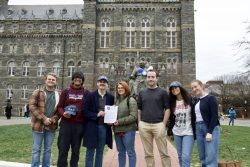Earlier this week, it was revealed that Map of the Modern World, the academic crucible of the School of Foreign Service, will undergo significant changes. James Reardon-Anderson, director of the Bachelor of Science in Foreign Service program, presented the new curriculum, which will focus more heavily on physical geography and its role in international affairs.
The changes will be embodied by three lectures on the fundamental forces that shape physical geography at the beginning of the course and a final lecture on global climate change. Reardon-Anderson, who will be teaching the class, acknowledged that the changes are part of the SFS’s effort to increase its students’ exposure to the sciences.
The class, considered an institution within the SFS, already has many students rising up to reject the changes. The Facebook group “Take Back Map of the Modern World,” created quickly after the story broke, had over 370 members as of Wednesday afternoon. Dave Nulsen (SFS ‘12) said he joined the group because he thought the changes were a mistake, and explained that “geography takes a backseat to politics” in the formation of nations.
It does not appear, however, that the changes to Map of the Modern World will ignore politics or culture. The inclusion of physical geography will serve to better explain the development of cultures and ethnic identities that shape international affairs and conflicts. Throwing in science for science’s sake would be a mistake, but that does not seem to be the case here.
It does not look like the class will be any less demanding than the Map of previous years. In fact, more emphasis will be placed on the work that students do out of the classroom, in order to relate the lectures back to the political map.
While it is understandable that many SFS students feel strongly about this issue––Map is a universal experience for SFS students––it is not wise to protest the changes without giving them a try first. The new course is looking to address Map of the Modern World in a more holistic manner than it had previously; the least we can do is wait for a semester to see if it succeeds.





I completely support the added focus to this course. As the Voice notes, don’t knock it until you try it! And the question of the role of physical geography in politics is an often overlooked one. You may find yourselves approaching politics and policy with a new, geographically-enhanced, perspective.
I fervently believe a bit of physical geography would benefit international studies students. Understanding the basics of what terrain, resources, and climate are in a place has impacts on culture, economic possibilities and a host of interrelated issues. It is amazing to me how many students in my geopolitics courses have no basis, no mental map in which to situate world events.